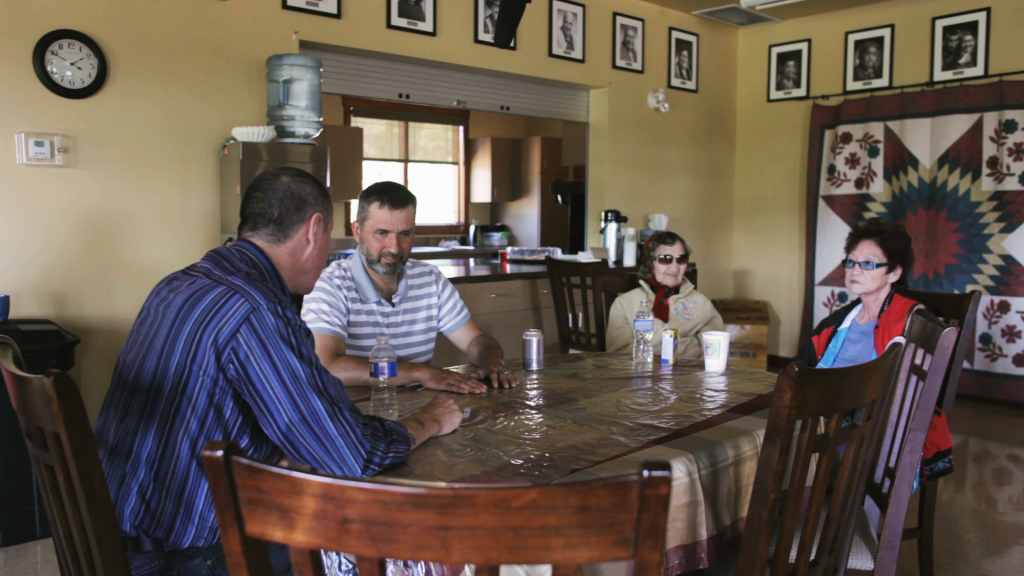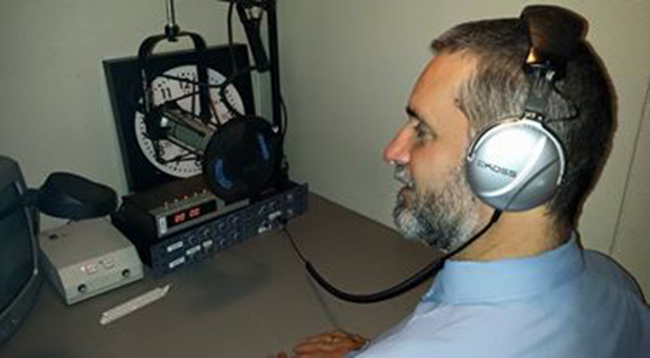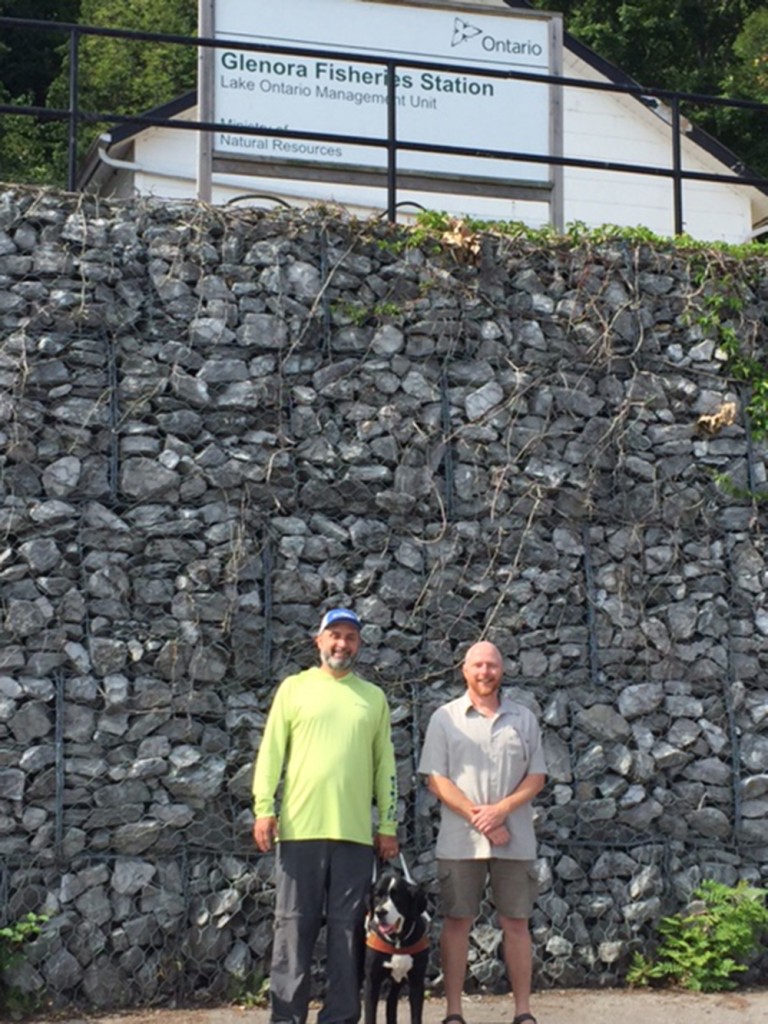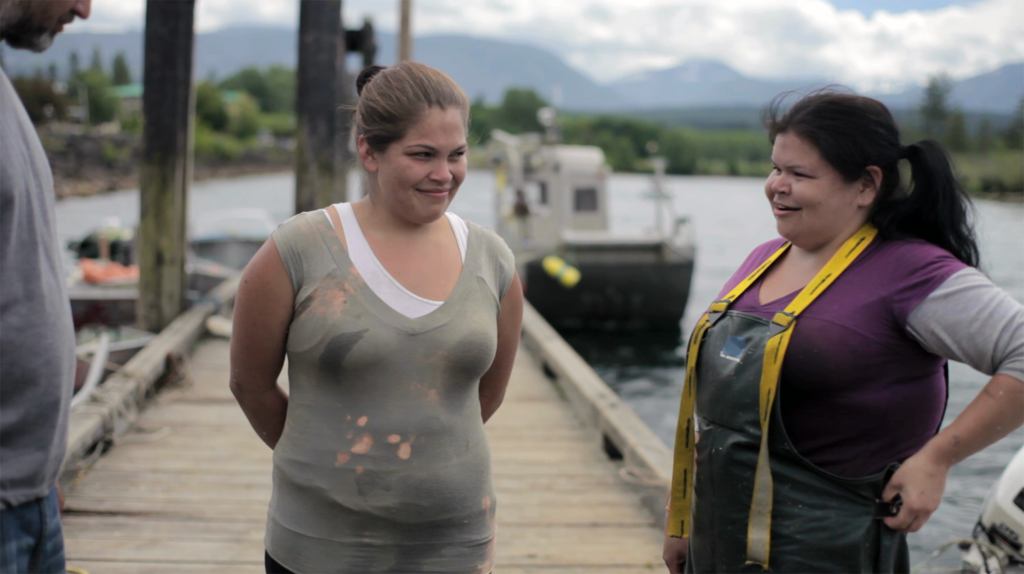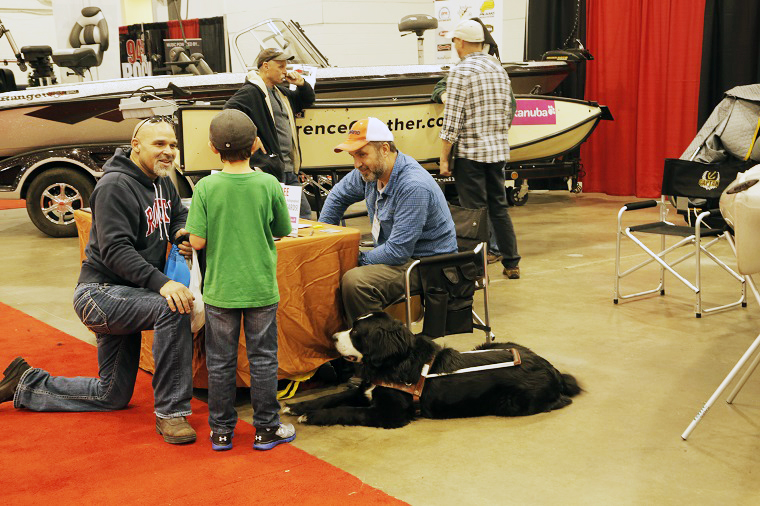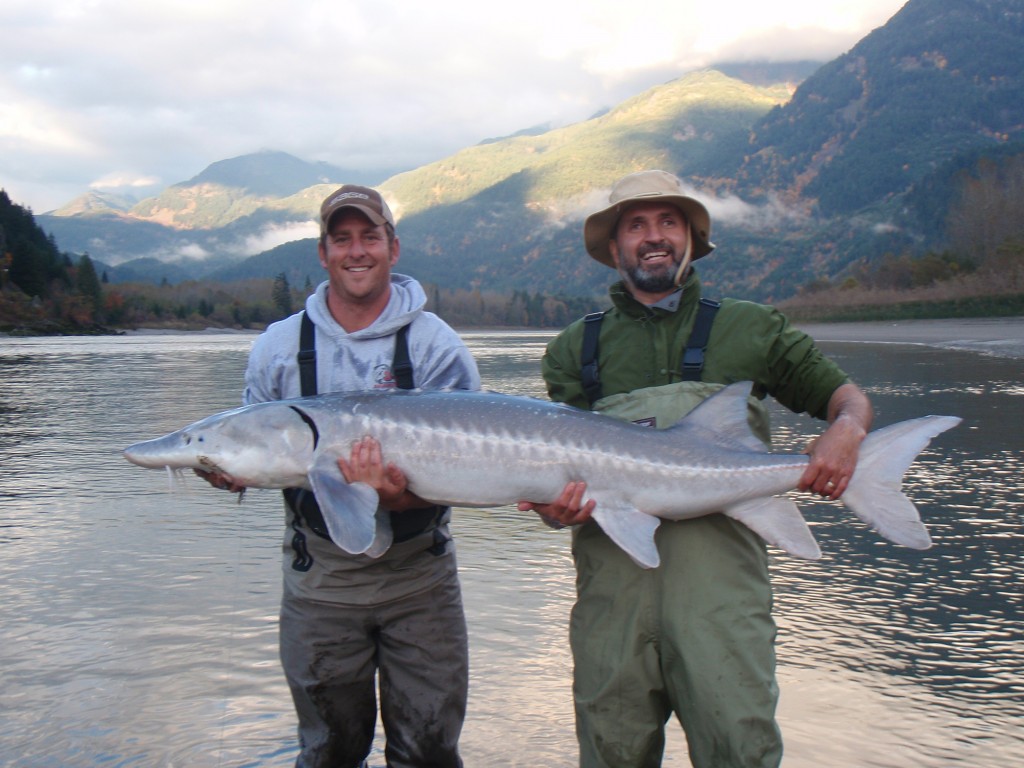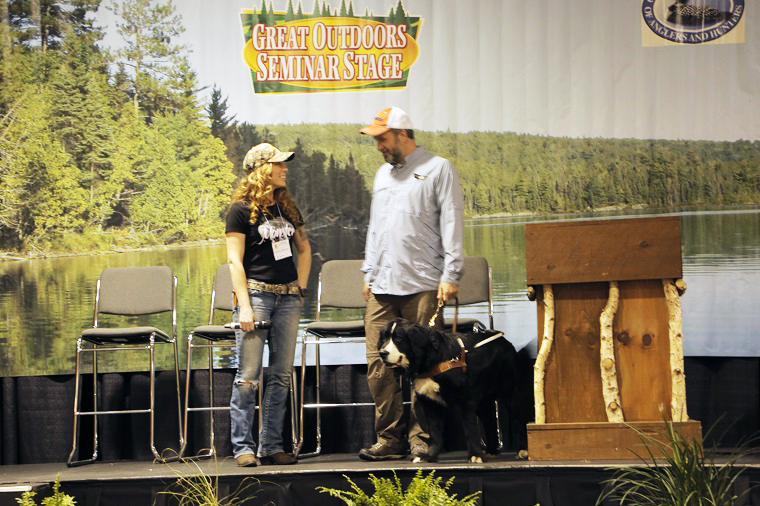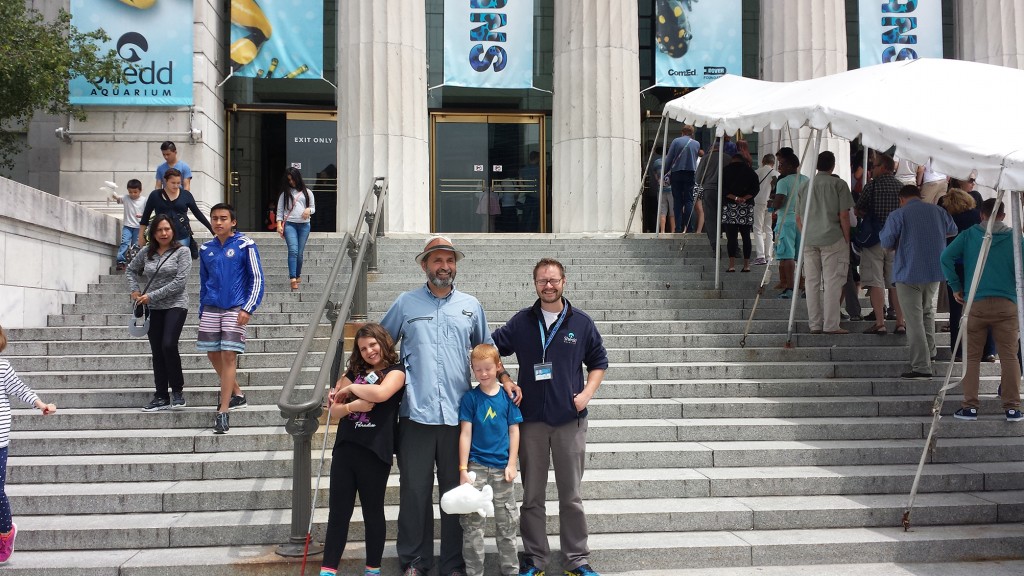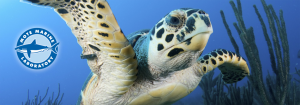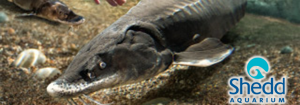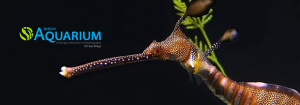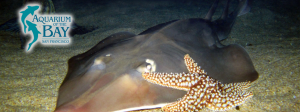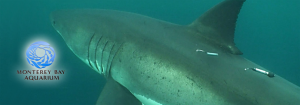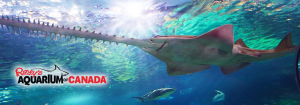
In partnership with the City of Ottawa, Blue Fish Canada is distributing shoreline clean-up kits that include a garbage bag and disposable gloves contained within a biodegradable wrapper. The kits are slim, light and fit easily into any size tackle bag or glove box. Get your free kit and be prepared to tackle unsightly messes!
Contact Blue Fish Canada today to arrange to receive a kit, or to have kits sent to your organization.
Email: bluefishcan@gmail.com

Short audio format Blue Fish Canada Stewardship Fishing Tips are produced by Blue Fish Radio with support from Eukanuba pet foods. Each 2-minute tip explains how listeners can ensure the future of fish and fishing.
The following 20 Blue Fish Canada Stewardship Tips can be rebroadcast at no cost. Let us know if you would like to rebroadcast the tips by emailing bluefishcan@gmail.com.
Blue Fish Canada Stewardship Tips:
BFC-Tip 1 — Fertilizers: What you can do as a shoreline property owner and citizen to reduce the amount of phosphates and nitrogen’s entering our water.
BFC-Tip 2 — Catch and Release: Tips for ensuring the safe release of caught fish.
BFC-Tip 3 — Fish Slime: The importance of avoiding the removal of slime from fish.
BFC-Tip 4 — Fishing down Deep: Why certain fish should not be fished at depths below 30 feet if you intend to release them afterwards.
BFC-Tip 5 — Harvesting: Which fish to keep for a meal, and which need to go back.
BFC-Tip 6 — Invasive: How to stop the spread of invasive life forms into new bodies of water.
BFC-Tip 7 — Oil and Gas: Making sure we handle oil and gas so it doesn’t impact our water and fish.
BFC-Tip 8 — Photography: Taking photos sustainably of memorable moments and trophy fish.
BFC-Tip 9 — Regulations: Knowing the regulations that govern our recreational fisheries and when to apply reason.
BFC-Tip 10 — Research: Anglers play an important role in citizen-based science.
BFC-Tip 11 — Big Boat Little Boat: Kayaks are great, but we still need to get out and back safely.
BFC-Tip 11 — Big Boat Little Boat
BFC-Tip 12 — Dogs on Boats: Keeping our four-legged friends safe aboard our boats.
BFC-Tip 13 — Catch, Release or Keep: More tips on harvesting sustainably.
BFC-Tip 13 — Catch Release or Keep
BFC-Tip 14 — Mentoring the Next Generation: Passing on knowledge on how to fish sustainably.
BFC-Tip 14 — Mentoring the Next Generation
BFC-Tip 15 — Catch your Limit, Limit Your Catch: We have harvest limits but sometimes we need to know when it’s time to limit our harvest.
BFC-Tip 15 — Catch your limit, limit your catch
BFC-Tip 16 — Disposing Old Fishing Line: Fishing line can result in death for wild critters if not disposed of properly.
BFC-Tip 16 — Disposing old fishing line
BFC-Tip 17 — Lifestyles Flow Downstream: Understanding that all we do impacts all life that lives downstream.
BFC-Tip 17 — Lifestyles Flow Downstream
BFC-Tip 18 — Live Bait: Ensuring our live bait doesn’t become the cause of the next invasion or disease outbreak.
BFC-Tip 19 — Right Size Tackle: Matching the size of rod, reel and line for the job is an important part of fishing sustainably.
BFC-Tip 19 — Right Size Tackle
BFC-Tip 20 — Pack it in, Pack it Out: Boy Scouts have it right when they teach kids to leave things the way they found them or better.
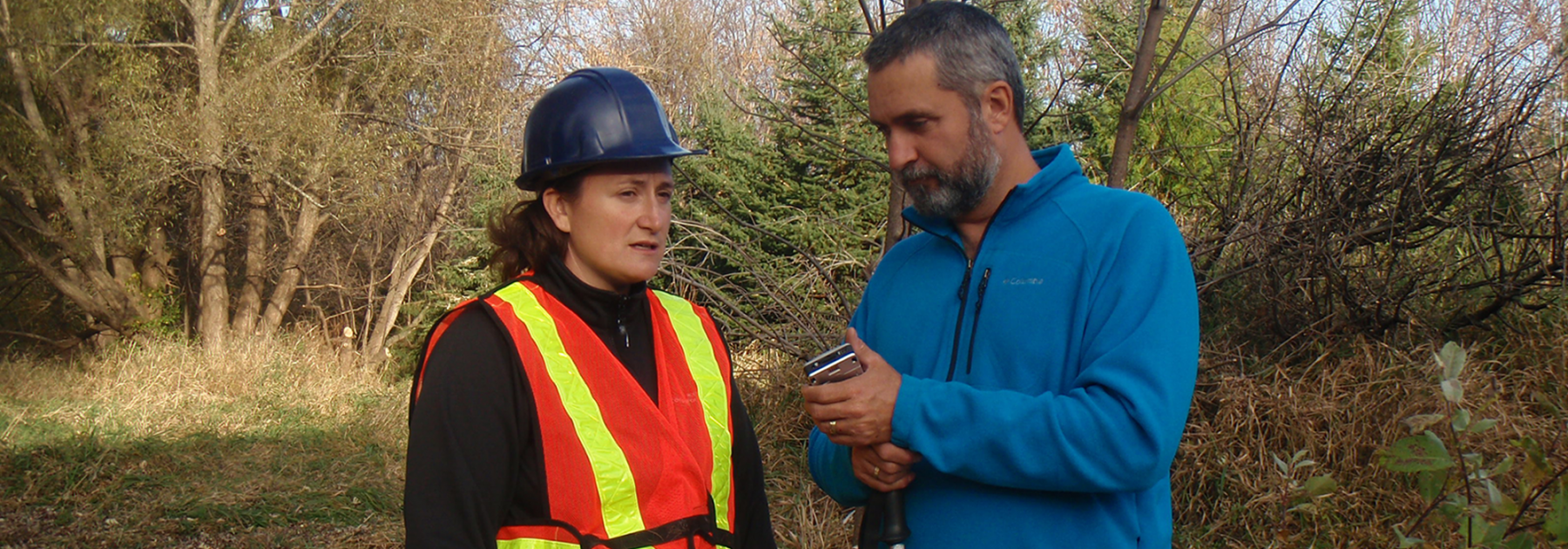
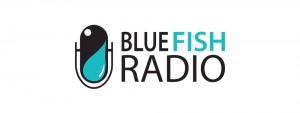 Blue Fish Radio (www.bluefishradio.com) Broadcast Weekly to over 100,000 Listeners. A weekly 30-minute podcast featuring Lawrence Gunther (www.lawrencegunther.com) Interviewing amazing people who are working hard to ensure the future of fish and fishing. Join the over 100,000 weekly Blue Fish Radio listeners for the latest news and tips on sustainable fishing.
Blue Fish Radio (www.bluefishradio.com) Broadcast Weekly to over 100,000 Listeners. A weekly 30-minute podcast featuring Lawrence Gunther (www.lawrencegunther.com) Interviewing amazing people who are working hard to ensure the future of fish and fishing. Join the over 100,000 weekly Blue Fish Radio listeners for the latest news and tips on sustainable fishing.
Broadcasters:
- iTunes – “The Blue Fish Radio Show”
- Spreaker.com – www.spreaker.com/show/the_blue_fish_radio_show
- WRVO Outdoor 24-7 Outdoor Radio – www.renoviolaoutdoors.com
- Accessible Media Inc. Audio – www.ami.ca
- Outdoor Canada Magazine – www.outdoorcanada.ca/
- Outdoors Unlimited – www.odumagazine.com
Follow on Twitter @lawrencegunther

As the president of Blue Fish Canada, a federally incorporated registered charity focused on ensuring the future of fish and fishing, it’s with great pleasure and considerable pride that I’m able to announce the documentary I researched, wrote and hosted, “What Lies Below” has been selected to compete in the Canadian feature film category at the 2016 Planet in Focus Film Festival. Even better, the documentary has been chosen as the closing film for the festival on Oct. 23 at the Rogers Hot Docs Theater in Toronto, and will be part of the International Eco Hero Awards ceremony honoring Alexandra Cousteau.
What Lies Below presents ten significant fish habitat and sustainability stories and the concerns, fears, hopes and actions of the people I met and fished with who live by and from the water. In making this documentary, my goal was to explore issues facing Canada’s waters and wild fish stocks, and what people are doing to ensure the future of these important resources. In the words of the Executive Producer, Alex Sliman, CEO of Cinelande Inc, “It’s through Lawrence’s ability to perceive without the use of his sight that the rest of us will learn the truth about what’s really happening beneath the surface of our rivers, lakes and oceans”.
A special sneak-peek screening of the documentary is being organized by the Fresh Water Alliance as part of the 2016 Living Water Rally in Vancouver. More screenings are being organized across Canada.
What Lies Below from tech@post430.com on Vimeo.
The launch of “What Lies Below” represents a culmination of thousands of volunteer hours, the investment of considerable private resources, and a commitment by all those who worked and took part in its filming to ensure the future of fish and fishing. Profits from the documentary will go to Blue Fish Canada, to support programs to train people to fish sustainably and safeguard their aquatic resources.
It’s now up to all of us to get the message out that we all have a part to play. Sharing and liking the news of the launch through social media is one such action. Another is directly supporting Blue Fish Canada by making a donation.
Like us on Facebook: WhatLiesBelow
Follow us on Twitter: WhatLies_Below
Make an online tax deductible donation to Blue Fish Canada.
I thank you in advance for taking the time to consider how you might provide your support. Given the camouflaging properties of water, it’s far to easy to allow our rivers, lakes and oceans to be used as convenient waste receptacles, and to harvest fish unsustainably. Blue Fish Canada is working hard to educate people how to engage with our water and fish resources in ways that will allow humanity to establish a symbiotic relationship with our aquatic ecosystems, both now and in the future.
Sincerely,
Lawrence Gunther Euteneier
President
Blue Fish Canada
Email: Director@BlueFishCanada.Ca
Twitter: @LawrenceGunther
Web: www.BlueFishCanada.ca
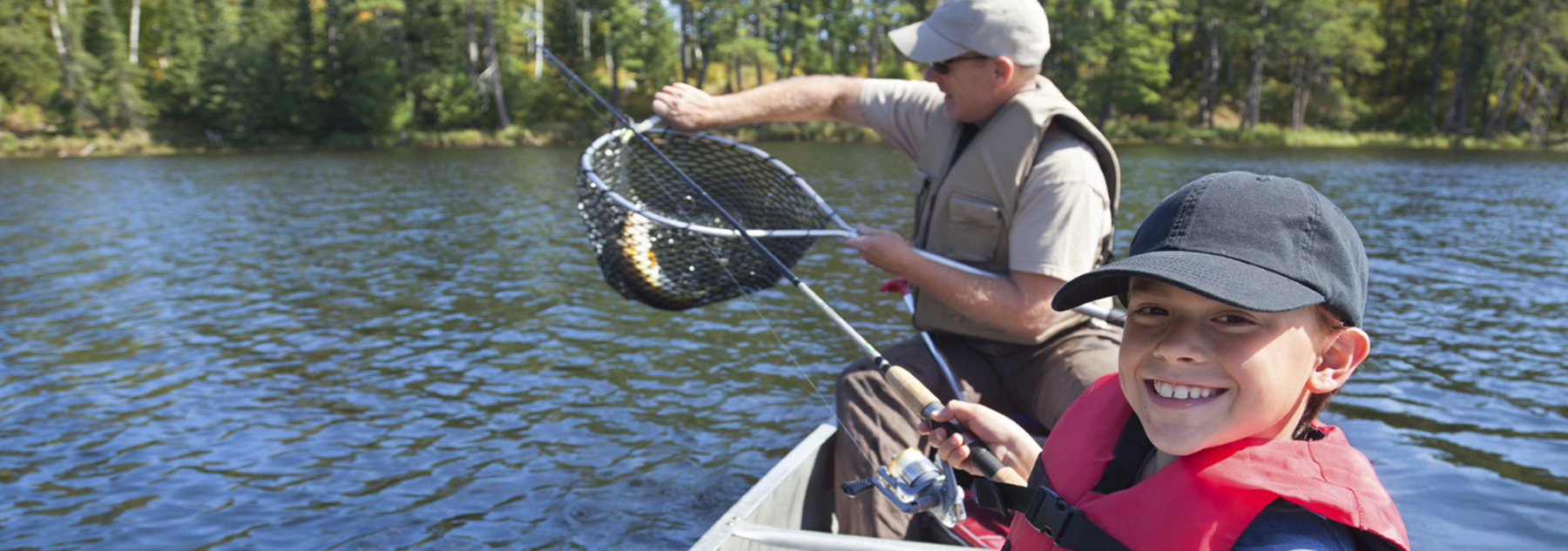 [Download PDF]
[Download PDF]
TOP TEN TIPS:
- Use the right strength tackles so returned fish aren’t overly tired
- Don’t over harvest and don’t keep the larger breeders
- Be careful fueling engines to avoid polluting water.
- Recycle old fishing line so it doesn’t tangle and kill wildlife
- Clean-up shoreline waste and garbage.
- Take measures to stop Nitrates or Phosphates from entering the water
- Minimize time fish spend out of the water, and avoid removing a fish’s protective slime.
- Use barbless or non-offset circle hooks, and environmentally safe artificial baits.
- Be careful not to transport invasive fish and plants, or to spread disease
- Support fish health research by reporting tagged fish
Algae Blooms:
Nitrates and phosphates added to the water can lead to excessive growth of algae and algal blooms. Decomposing algae causes oxygen depletion and fish kills. Avoid using fertilizers mid-summer or when the ground is frozen. Maintain a natural buffer zone between your lawn and the shoreline. Have your septic system inspected annually.
Invasive fish and Disease:
Don’t Dump your Minnows. Invasive species of baitfish can overwhelm native fish species, or can spread disease. Purchase bait from dealers selling certified disease-free bait. Dump unused bait on dry land. Use baitfish only in waters where their use is permitted
Invasive Plants:
Invasive plants can often outgrow, replace, and destroy native plants. Be sure to remove seeds and plant matter from boots, waders and gear. Clean your boat and trailer thoroughly before transporting it to another body of water. Verify that any plant you buy is not invasive. Don’t release aquarium fish or plants into the wild.
Trash:
Pack it in, pack it out. Don’t leave used fishing line behind as it can tangle and kill wildlife. If you see garbage, clean it up.
Oil and Gas:
Keep engines and containers in good working condition and be careful when transferring new or used oil or gas. Have sorbent materials available should a spill occur. Label all containers appropriately.
Tackle:
A lip hooked fish stands a better chance of survival. Using single, barbless hooks or circle hooks are easier on fish. Non-lead weights or jigs are better for the environment, as are biodegradable soft plastic baits. Needle-nose plyers and hook cutters are essential.
Playing Your Fish:
Fighting a fish to exhaustion will decrease its chance of surviving. Use properly sized tackle to land fish quickly. Revive your fish in the water after being unhooked. When water temperatures are high, avoid exposing fish to air.
Photographing Fish:
Be ready. Have your camera handy and accessible before you land your fish. Keep your fish in the water and only lift it out when ready to take the photograph.
Handling Fish:
Wet your net before netting your fish, and always handle fish with wet hands. Don’t lay fish on carpet or grass and try not to let your clothing wipe important slime from the fish’s body leaving it open to infection. Fish that flop about on streamside rocks or the bottom of a boat harm themselves and expend undue energy. Keep a fish’s head in the water during the hook removal process. Never grab a fish by the eyes or gills. Avoid squeezing fish around the belly or hanging fish vertically as this can damage internal organs. Fish that seem unlikely to survive should be harvested.
Selective Harvesting:
Harvest fish from populations that can support a reduction in their numbers, from ecosystems that are thriving, and in sizes that ensure larger breeders carry on. Removing small numbers of mid-sized fish can ensure the remaining fish have sufficient food to reach full size.
Fish Research:
Anglers who report recaptures of tagged fish provide data that is vital to determining fish health. Report tagged fish including where and when the fish was caught, the tag number, and the size and weight of the fish. Return tagged fish to the water so the research might continue.
Regulations and Conservation:
Purchase your fishing license yearly so data on numbers of fishers can be collected, and to support fish research and conservation. Go on line and know the fishing regulations for the species of fish and area your fishing. Verify whether the fish you plan to harvest are safe to eat and in what amount. Finally, report toxic spills, fish kill-offs, and the illegal behaviours of others.
Thanks:
This Guide was made possible with the generous support of Oziles Marina, the Petrie Island Fishermen’s Association, and the Canadian National Sportsman Show.
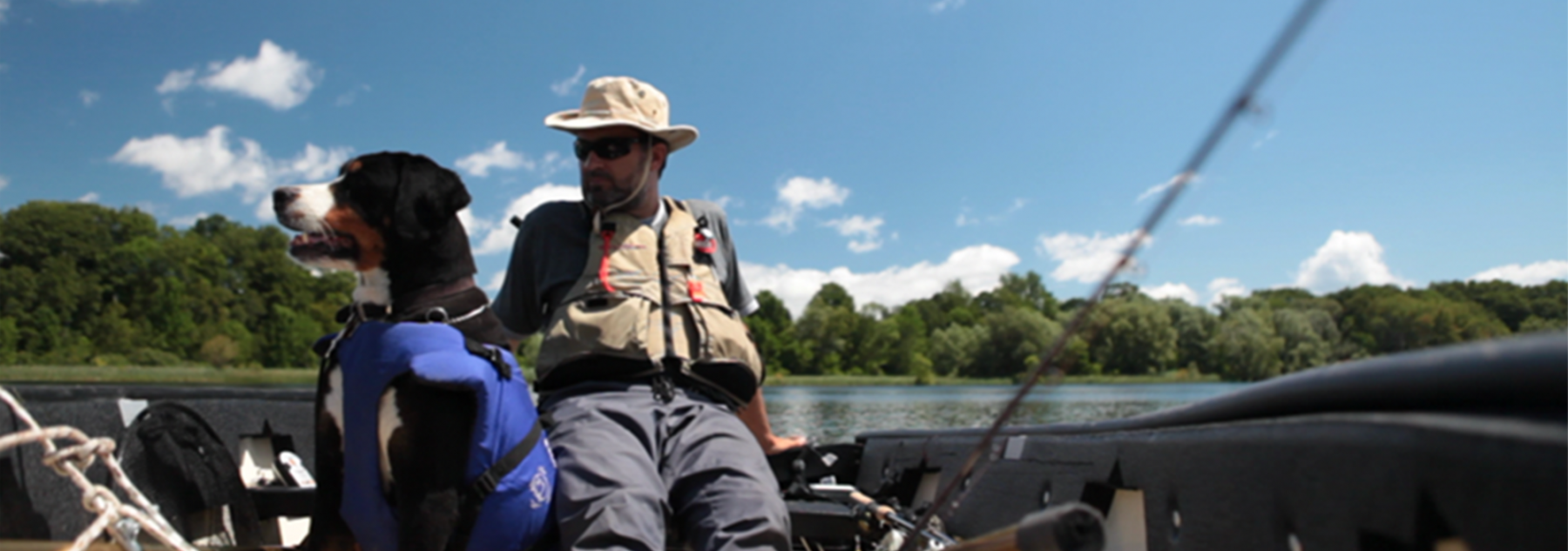
Since Blue Fish Canada’s federal incorporation and registration as a charity in 2012, the 2016 year has been our most productive year to date. As President, it’s my honor and pleasure to offer this accounting of a number of the many program accomplishments achieved over the past year.
Conferences:
In September Blue Fish Canada received a grant to participate in the 2016 Living Water Rally hosted by the Canadian Freshwater Alliance. Rally participants were presented a summary of our work with research aquariums of North America with specific focus on actions taken to include instructional program content of specific interest to anglers. Over 8-million Canadians fish recreationally, and are seeking knowledge to become even stronger stewards of their aquatic ecosystems. By BFC working with Aquariums, our reach to provide this knowledge is expanded.
Rally organizers also hosted a special sneak-peek screening of our documentary, “What Lies Below”. Response from Canada’s leading water activists was outstanding. They loved the narrative of a blind angler and activist exploring Canada’s aquatic challenges, and the actions taken by people who live by and from the water.
Mainstream Media:
The CTV Morning TV program joined Blue Fish Canada for a morning of live TV broadcasts, (9 segments totaling 21 minutes). The show’s host caught fish while receiving tips on fishing sustainably. Four of the longer segments were uploaded to YouTube (www.FeeltheBite.TV) and disseminated over social media.
The Canadian Broadcast Corporation produced an 8-minute radio segment with Blue Fish Canada to kick-off Family Fishing Day. We recorded the bulk of the segment on the shore of the Rideau River. It covered the work of Blue Fish Canada and encouraged families to enjoy the license-free fishing weekend.
Every second Tuesday Blue Fish is a featured expert guest on AMI’s Audio program, “Live from Studio Five” broadcast live across Canada on SiriusXM, Cable TV and the internet. Our contribution involves providing insight and analysis of topical news items of relevance to the environment.
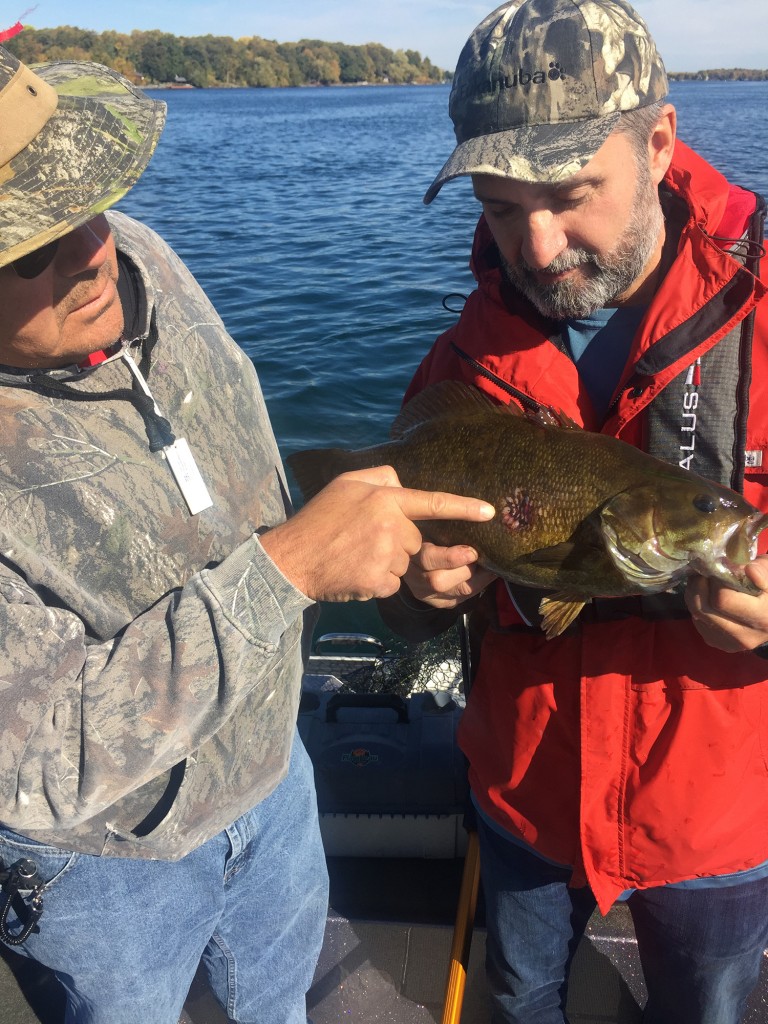
Lawrence with Mohawk Norman Peters holding an St. Lawrence Smallmouth Bass that shows evidence of a Lamprey attack
Public Service Announcements:
The 20 Stewardship Fishing Tips produced for Blue Fish have been airing on a number of podcasts and internet streaming services. Short information segments intended to educate anglers how to fish sustainably and protect their waters. More tips are in the works.
Social Media:
“Sustainable Fish Friday”: is a new weekly social media initiative featuring short 1-minute stewardship tips up-loaded to Sound Cloud. People can click and listen directly to the audio track over their portable devices.
Youth Initiatives:
A favorite annual event of the 150th Ottawa Girl Guides is the chance to go shoreline fishing with Blue Fish volunteers. The mentors provide the gear, and over 50 girls ranging in age from 6 to 16 catch plenty of panfish. A Q/A session follows to answer questions about the fish caught and released, and highlight important lessons learned about fishing sustainably. Many of the girls now can bait their hooks and release their catch.
Print Media:
Articles featuring the work of Blue Fish appeared in 12 newspapers and Magazines. In addition, magazines such as Outdoor Canada, Outdoors Unlimited and Fish Hunt Ride are now carrying quarter-page ads featuring the work of Blue Fish, as well as through their on-line and social media content.
Podcasts:
The weekly Blue Fish Radio podcast continues to be featured on AMI Audio over SiriusXM, cable TV and the web, and on WRVO Radio Network One for a total of 12 times weekly. A number of partnerships have also been established to promote new episodes. Episodes can be streamed or downloaded from iTunes and Spreaker.Com. It’s estimated that well over 100,000 listeners hear Blue Fish Radio podcasts each week.
Documentary:
Following a highly successful sneak-peek screening of What Lies Below at the Living Water Rally, its premiere was held in Toronto at the Rogers Hot Docs Theatre. It went better than hoped. Over 600 people were in the audience and stayed for the Q/A session afterwards.
The following review is one of several:
From TheGate.ca: This year’s closing night film (screening at Hot Docs Ted Rogers Cinema alongside the festival awards ceremony) comes from Canadian filmmaker Emanuel Hoss-Desmarais, whose last film was his stunningly gorgeous debut feature Whitewash, starring Thomas Hayden Church as an alcoholic Quebecois plow driver who makes a deadly misjudgment. His follow-up is What Lies Below, an equally stunning documentary that focuses on Lawrence Gunther, a legally blind environmental advocate documenting the effects of waste, sewage, and pollution on fish populations and water supplies. The most gorgeous looking film at this year’s festival (which actually says a lot for an environmental film showcase), What Lies Below balances the personal, the political, and the environmental wonderfully, making the audience learn just as much about Lawrence as they do the world around him. It’s a disarmingly emotional experience that proves beyond a shadow of a doubt (and please pardon the pun) that we can’t keep turning a blind eye to how we treat the world around us.
What Lies Below is set to appear in another four festivals in 2017 throughout the world. Broadcast Deals are being signed with CBC’s Doc Channel and AMI TV.
Exhibits:
Blue Fish exhibited over nine days at two outdoor shows in Ontario in 2016 to an estimated 150,000 show visitors. Our exhibit spaces (Ottawa – 20-30, and Toronto – 20×50) were generously made available at no cost by Canadian Sportsman Show Management Services. With Guide Dog “Moby” in attendance and a quality Shimano spinning combo to raffle off, we had a steady stream of visitors scooping up free clean-up kits and stewardship training materials, and making cash donations. .
Shoreline Clean-Up Kits:
Blue Fish Canada continues to work in partnership with the City of Ottawa to distribute free shoreline clean-up kits consisting of a garbage bag and disposable gloves contained within a 5”x6” thin biodegradable wrapper. Over 3,500 kits were distributed by hand, and are available over the Blue Fish Canada website.
Stewardship Training Materials:
The “How to be a Steward of your Favorite Fishing Hole” brochure continues to be distributed for free over the internet and by hand. Over 2,000 copies were distributed in 2016. The brochure is packaged with a 3’x8’ double-sided leaflet explaining the mission of Blue Fish, and a $5 pet food coupon from Eukanuba.
Seminars:
Fifteen seminars / key note addresses were delivered throughout the year featuring the mission of Blue Fish, why the programs are necessary, and the positive response from the public, water activists and anglers. Seminars generate working capital through donations to Blue Fish.
Research Aquariums of North America:
We have now featured the research, conservation, rescue, volunteer, and education programs offered by nine leading aquariums across North America through 20 blogs and podcasts. The many partnerships formed through the initiative have resulted in considerable increased awareness of the important stewardship activities underway at both public aquariums and Blue Fish, and are serving to further educate anglers about fishing sustainably.
Donations:
Our partnership with “Canada Helps” continues to generate on-line donations. We are also beginning to see larger donations being made directly to Blue Fish from private individuals. Operating costs for Blue Fish are directly related to program delivery, which are implemented at no charge by our volunteer directors and volunteers.
Looking Forward to 2017:
*Discussions are now underway with the Vancouver Aquarium to establish a partnership between Blue Fish and their Great Canadian Shoreline Clean-Up initiative. They are looking to Blue Fish to bring Canada’s angling community into the initiative, and Blue Fish is seeking to build on their on-line mapping tools to further connect anglers to the care and cleaning of their favorite fishing holes.
*More seminars and festival screenings of What Lies Below are being planned, with the next phase to include TV broadcasts. Only after these channels have been fully tapped, will on-line “view on demand” services be established. All revenues generated by the doc continue to go to Blue Fish.
*Eukanuba has committed to continue to support Bleu Fish with the donation of pet food coupons and prizes. The coupons are being packaged with Blue Fish literature. Affiliations with pet and outdoor stores are being explored to distribute the material directly to customers, and to generate donations at point-of-sale.
*Presentations to clubs, organizations and corporations will continue, as will guest appearances on mainstream media. They love the narrative of a competitive professional tournament angler, who happens to be blind, cares about the future of fish and fishing and has a great looking guide dog”! It’s a 4-prong message that resonates strongly with the public, fellow anglers, water activists and dog lovers alike.
*Multi-media awareness and educational materials will continue to be produced and disseminated both directly and through partnerships. Subjects will focus on things we can all do to ensure the future of our water and fish. Guests and locations will be selected to demonstrate the positive impacts such actions have on aquatic ecosystems and fish populations.
*Last, an on-line stewardship quiz is in development for use as an educational tool. Those who take the quiz will be signed up for the Blue Fish newsletter and have their names entered into a draw to win a Shimano spinning combo and many other prizes.
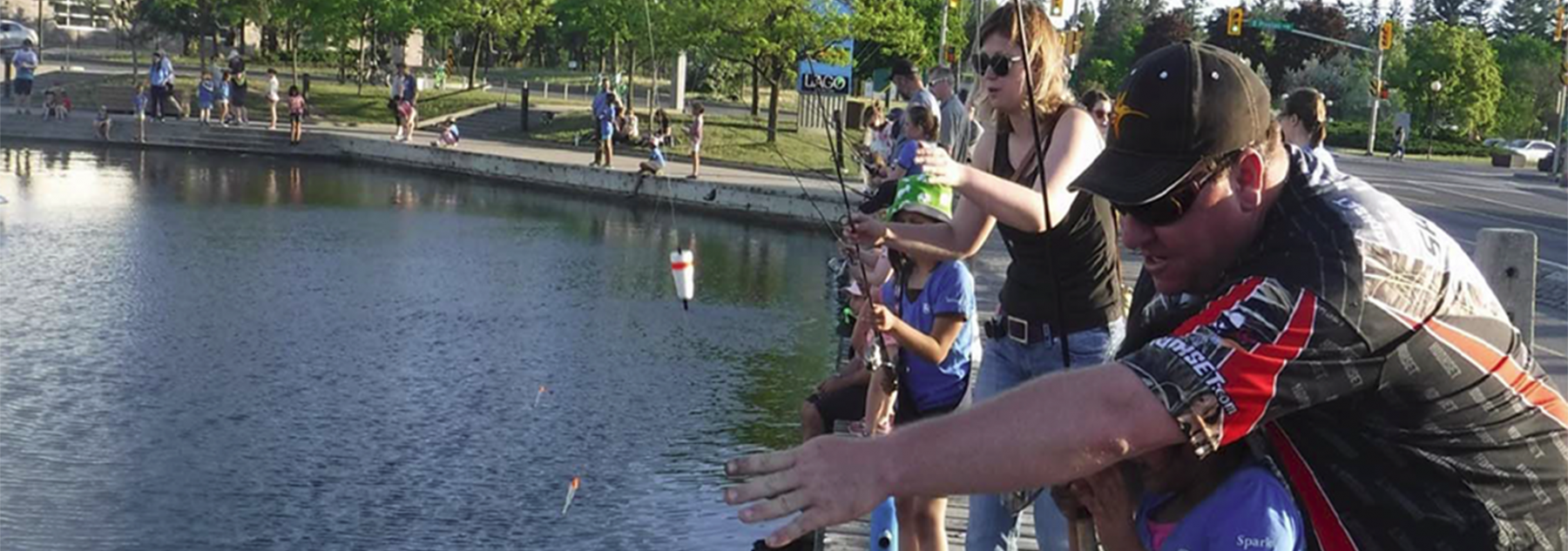
Lawrence Gunther, President of Blue Fish Canada, recently presented at the 2016 Living Water Rally organized by the Fresh Water Alliance. The presentation outlines how public aquariums and the angling community have joined forces in aquatic research and the training of future aquatic stewards. The presentation was extremely well received with a number of future partnerships now in the works.
Click here to download PDF of the presentation
Fishing, Anglers and Aquariums of North America
A Presentation to the 2016 Living Water Rally
By Lawrence Gunther, President – Blue Fish Canada
Introduction – Blue Fish Canada
- Federally incorporated charity January 2012
- Mandate: The future of fish and fishing
- Activity: educating and empowering anglers to be stewards of aquatic ecosystems
- Broadcasting Blue Fish Canada Stewardship Tip PSA’s
- Distributing stewardship training materials
- Providing Free shoreline clean-up kits
- Organizing 24-hour fishathon
- Distributing “What Lies Below” documentary
- Producing 20-part series focussing on research aquariums of North America
Anglers
- Anglers fish recreationally or for sport
- Catch-and-release and selective harvesting
- According to DFO, in 2010 there were 3.4 million active anglers in Canada
- Another ½-million anglers visited Canada
- 25% of adult anglers in Canada are women
- Fish on average 13 days annually – 43.5-million days
- Harvested approx. 63-million fish
- Released approx. 125-million fish
- Spent $2.5 billion directly on fishing in 2010
- $400-million on fishing packages
Commercial fishing In Canada
- Approximately 50,000 active commercial fishers
- Aquaculture industry employs about 3,500 people at 1,000 sites
- Preparation and packaging of fish employs another 32,000
- In 2010 850,000 metric tons of wild fish were harvested from Canada’s oceans
- Value of marine fish harvested = $2.8-billion
- Total freshwater fish harvested in 2010 was 2,100 metric tons
- Total value of freshwater fish harvested = $63-million
- Total value of fish product exported $6-billion
- Total value of fish product imported $3.5 billion
World Statistics
- An estimated 45 billion fish are caught by recreational anglers annually around the world – 2/3 are released back into the environment.
- Approx. 100-million metric tons of fish are commercially harvested annually worldwide.
- Roughly 2.7-trillion individual fish are harvested commercially around the world each year.
Fish
- First appeared 500-million years ago
- 90 million years later they developed jaws
- Over 33,000 species of fish
- 60% of all known species on earth
- More fish species than all birds, mammals, reptiles and amphibians combined
- Certain species (Sturgeon) stopped evolving 150-million years ago
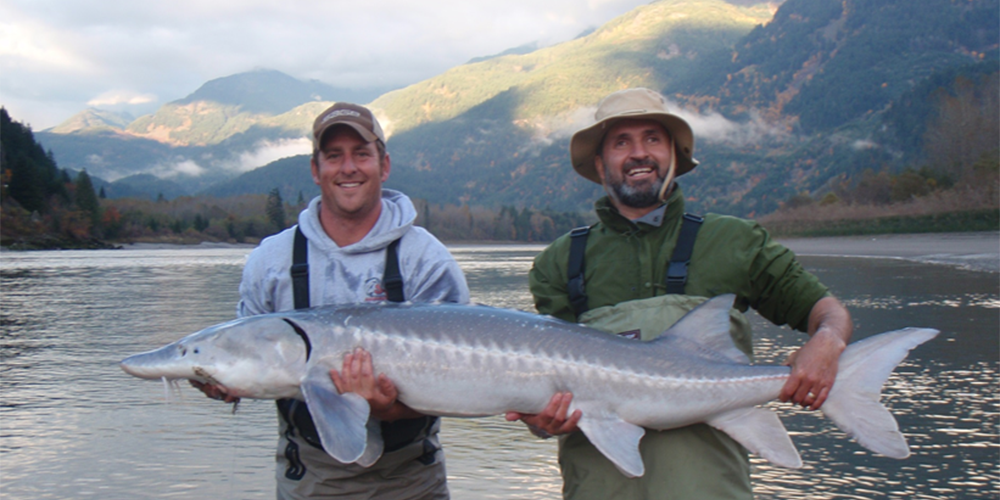
Aquariums
- North America’s zoos and aquariums receive an estimated 175-million visitors annually
- Comply with criteria established by Association of zoos and aquariums
- Many operate as non-profits and are active in their communities
- Aquariums are using internet / social media to engage visitors pre and post visit
- Programs include: Research, rescue, conservation, volunteerism, citizen-science, excursions, multi-sensory experiences, education and partnerships

Engagement
- Aquariums generate considerable cash and donation
- Mandate includes training stewards of aquatic ecosystems
- Recreational fishing is North America’s most popular outdoor activity
- Anglers contribute more volunteer hours to conservation than all other groups combined
- Both aquariums and anglers are leaders in engaging citizens about aquatic issues
- Establishing linkages between aquariums and anglers makes sense
Commitment
- Aquariums care about educating the public
- Aquariums entertain, engage and empower
- Anglers care about fishing sustainably
- Fishing forges bonds between anglers and their local aquatic ecosystems
- Harvesting wild local organic food is growing in popularity
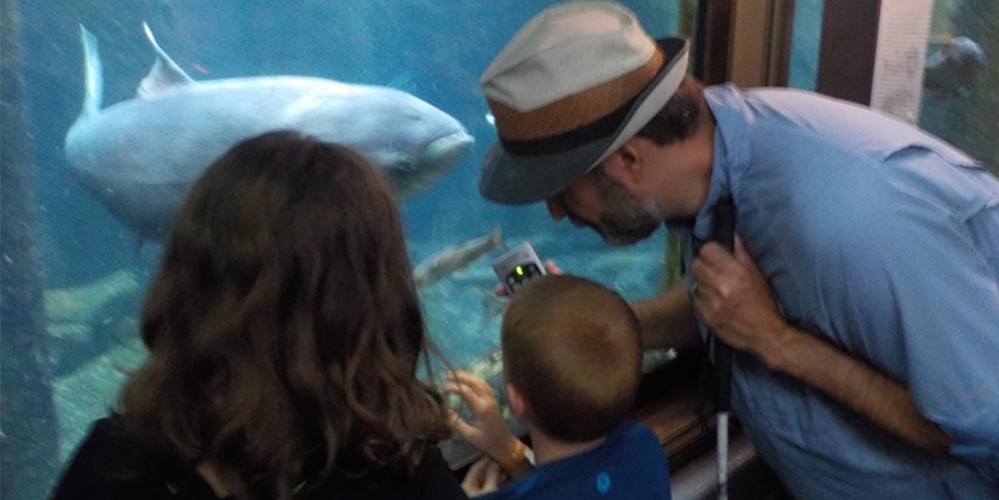
Action
- Aquariums using inclusive programming to connect with anglers
- Anglers supporting aquariums with research as citizen scientists
- Aquarium educational programming includes sustainable harvesting
- Anglers participate in fish habitat educational programming
THANK YOU! HAPPY FISHING!

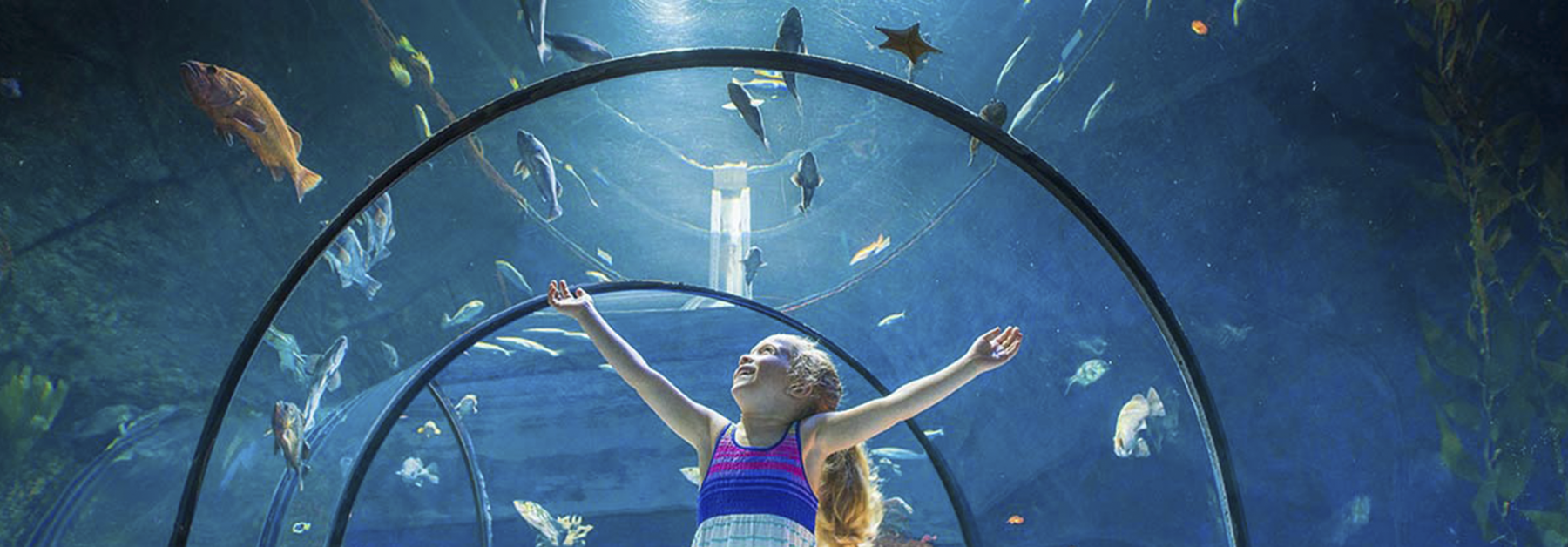
Join Lawrence Gunther, President of Blue Fish Canada and Host of the Blue Fish Radio show, as he visits aquariums throughout North America. This unique initiative goes behind the super-think glass and the thousands of gallons of water playing host to all manner of aquatic species. A behind-the-scene exploration of spaces and people doing amazing things to empower the future stewards of the world.
The Aquariums of North America feature showcases the mega-sized public displays that cost millions to build and require maintenance crews using SCUBA to clean. Aquariums that do more than entertain guests, in that they strive to recreate aquatic ecosystems in their full glory.
North America’s aquariums are making significant investments so people can both witness and experience the mysterious underwater world that we can only imagine when looking down from the decks of ships or bridges. A world that is surprisingly more diverse than that which we live in above water, and far, far larger in size. And a world that is in need of and deserving of protection.
Many of the more famous public aquariums in North America have been around for decades and yet don’t seem to be losing their public appeal. In fact, new aquariums are springing up everywhere as for-profit businesses. We at Blue Fish Canada wanted to find out what keeps these aquariums relevant and why interest in such exhibits is growing.
Surely, the variety of underwater documentaries and TV specials that Jacques Cousteau first made popular offer more than ample film footage to satisfy most people’s curiosity. So what is it that has people turning off their TV’s and tablets and visiting aquariums in ever-increasing numbers?
In researching and planning the Aquariums of North America special, we were acutely aware of the debate surrounding the welfare of some animals, particularly cetaceans, in captivity. With so many opinions already floating around on this topic, we wanted to take a different approach.
The aquariums Lawrence is visiting focus first-and-foremost on educating the public. Their methodologies include simple displays with information plaques, live presentations and video, and hands-on interactive displays intended to go beyond observation by providing a more multi-sensory experience. Other secondary program offerings often include behind-the-scenes tours, overnight experiences, meet-and-greets with leading scientists, participation in feeding sessions, excursions on boats, and the opportunity to volunteer or apprentice. The internet as a means of following up with support for past visitors interested in learning and doing more is also becoming a key component of most aquarium visits.
Some might argue that the very popular interactive exhibits exploit animals and other life forms, and these exhibits, along with the other secondary programs, are solely intended to give a bump to the numbers of people passing through their turnstiles. But if this is the case, then one also need ask, why? For the most part, these aquariums are not-for-profit organizations.
As a person without sight, Lawrence is one of the first to attest to the value of interactive exhibits. Simply pressing your nose up against the think glass of an aquarium leaves everyone feeling somewhat unfulfilled. The need to maintain our connection with nature can only be established and maintained when all the human senses are engaged–not just the sense of sight. Like babies, everyone has a deep-seeded need to explore the world with ones hands, mouths, ears, noses, and eyes. It’s how one establishes a real connection with the object being investigated. The aquariums Lawrence visits get this, and are leaders in the world in offering the public multi-sensory, four-dimension, full immersion (both figuratively and literally), emotionally engaging experiences.
Lawrence has already visited close to a dozen aquariums throughout Canada and the United States, and the number continues to grow. While there is some overlap in the sorts of educational displays offered by different aquariums, their ample differences made it easy to focus his attention on unique subjects relevant to each aquarium’s geographic location. What he learned may both surprise and impress you.
Links to live Blue Fish Radio recordings of Lawrence’s visits and interviews with aquarium staff can be found on www.bluefishradio.com and iTunes.
There’s no shortage of interesting topics covered: habitat protection and conservation, volunteer programs, environmental sustainability, field research and observation, rescue and rehabilitation, education and awareness, stakeholder engagement, heartbreak and success, and so much more. Each Blue Fish Radio Aquariums of North America episode is engaging, different, informative, loaded with surprises, and fun. Included is an interview with an expert from the Association of Zoos and Aquariums (AZA) during which Lawrence and his guest discuss the evolution of aquariums, the Association’s accreditation role, and what the future holds in store.
Please join Lawrence on this journey of discovery and illumination. You won’t be disappointed. As someone who sees the world through his ears, Lawrence has a pretty good idea of what makes for good radio.

Once again Lawrence Gunther, President of Blue Fish Canada, has been selected to present at the Canadian Freshwater Alliance’s Living Waters Rally (September 28-30 2016, Vancouver). The topic of Lawrence’s presentation will be the role research aquariums are playing in recruiting new water stewards and their strong connection to fishing. This is the third Rally in a row Blue Fish Canada has had an active role in supporting the Canadian Freshwater Alliance in delivering.
For more on the 2016 Rally link to: http://www.freshwateralliance.ca/
During the 2013 Living Waters Rally Lawrence Gunther presented on the connection anglers and fishers have with water and fish, and their commitment to ensure this connection continues for many future generations.
The following will take you to a 20-minute audio recording of Lawrence’s presentation:
In 2014 Blue Fish Canada was part of the organizing committee for the Living Water Rally. The following statement was issued by the Canadian Freshwater Alliance, a project of Tides Canada, and organizer of Living Waters Rally 2014:
Canada’s waters are suffering. Lakes are choked by algae blooms. Rivers are overflowing their banks, with others dangerously close to drying up. Drinking water supplies are compromised. Struggling fish populations are often unfit for consumption.
Healthy, living waters are essential to the health and prosperity of our communities and the survival of all species. We are blessed in Canada to still have some of the world’s most pristine waters and thus a global obligation to protect them and to restore those waters that are suffering—before it’s too late.
This past weekend, 110 delegates of Living Waters Rally 2014—representing recreational, indigenous, cottage association, faith, philanthropic, environmental, business, academic, and arts and culture groups from across Canada—came together to discuss the future of Canada’s freshwaters.
The people of Canada deserve to know the health of their home waters and that many are increasingly at risk and need to be able to know which ones are healthy. We need regular, independent public assessment of and reporting on the health of our waters.
Protecting and restoring the health of our waters will require leadership. Canada needs a legal and policy framework that sets a high standard of accountability and transparency.
Indigenous peoples, including First Nations, live in harmony with nature and place a spiritual and sacred value on water and have rights to maintain and strengthen their relationships with traditionally occupied lands and waters pursuant to treaties, aboriginal title and aboriginal rights. Hence, indigenous peoples engage in the movement to protect our waters.
We invite many more people and organizations to be engaged in the protection and restoration of Canada’s freshwater. We will build and strengthen the water movement to ensure that all our waters are in good health—swimmable, drinkable and fishable.
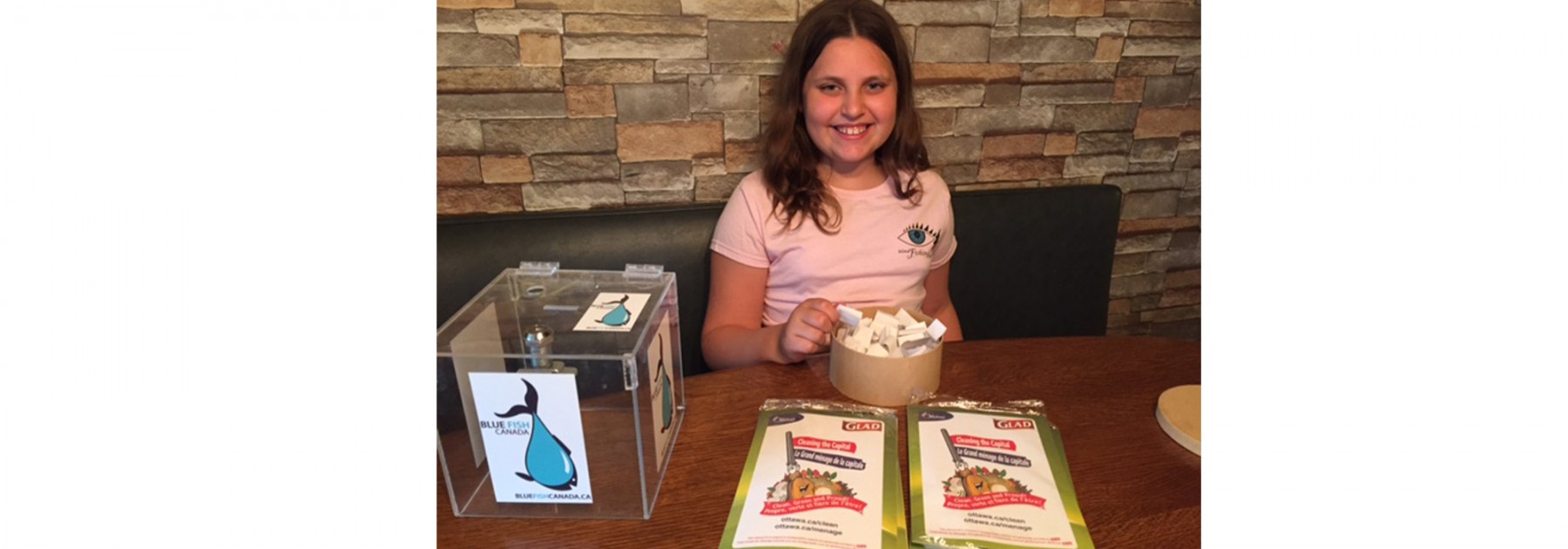
During the spring 2016 outdoor show season, Blue Fish Canada exhibited for a total of nine days. Thanks to Canadian National Sportsman Show management for generously donating exhibit spaces.
Blue Fish Canada gave away over 5,000 shoreline clean-up kits, Fishing stewardship guides and personalized brailled autograph cards to visitors at our boot. People donating $5 or higher, had their names entered into a draw to win a $250 Shimano fishing rod and reel outfit. Over $400 in donations were collected.
One of Blue Fish Canada’s youngest and hardest working volunteers, Lilly Euteneier, drew the winners name on June 1, 2016. The winner is Chris Walcott.
Thanks to all those who dropped by the booth to say high and who generously donated funds to support Blue Fish Canada to empower the next generation of fish stewards. Big thanks too, to all those who gave their time to help staff our booths.
 Blue Fish Canada/Poisson Bleu Canada
Blue Fish Canada/Poisson Bleu Canada